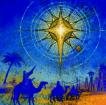
The Greg Jenner Papers
NIBIRU AND THE LEMURIAN CONNECTION
Part Two
“…The vault in which this tomb was found was illuminated by the SUN OF THE MAGI, and inscribed with magical characters. The body of the illustrious founder [Christian Rosenkreutz] was discovered in perfect preservation…”
Quote from the ‘Encyclopedia of Occultism and Parapsychology’ ©1978. Vol. 2; Page 788.
INTRODUCTION
In Part One of this paper a supporting list of evidence is presented suggesting that North American Rosicrucians inherently know all about the ‘lost continent of Mu’ and pride themselves on a Lemurian philosophy still entrenched in their society today. Parts Two and Three go one step further by exposing the European history of the Rosicrucians including some of the precious secrets brought fourth with them to present day.
Before I commence, however, the reader should know that I am not in any way, nor do I wish to be, affiliated with the Rosicrucian or Mason brotherhoods. With this in mind, my research can only scratch the surface of their esoteric knowledge, reserved only for the highest initiates, of course.

Be that as it may, from what I have uncovered, both fraternities hold dear the fundamental core belief of a physical subterranean realm—especially the Rosicrucians. This paper includes romantic tales that shed light not only on their tradition of an ‘Underground Empire’ (to be addressed in Part Four) but also their knowledge of the Universe. Particularly the existence of another mystic sun in our solar system known as “The Sun of the Magi” linked to Christian Rosenkreutz’s tomb itself. Are these romances true? You be the judge, although various members of the Theosophical Society say YES!
TALES FROM THE UNDERGROUND CONTINUED…
The first romance I’ve provided has all the hallmarks of ‘Moria’ in Tolkien’s Lord of the Rings. This yarn takes place in Staffordshire, England; circa 1675 and tells the tale of a farmer who stumbles across a subterranean staircase leading deep underground to a stone chamber occupied by a mysterious elder reading some-sort of ancient manuscript. You can read the entire account below:
Exhibit H) Leslie A.
Shepard (![]() Encyclopedia Of Occultism And Parapsychology: Vol 2 ©1978)
Encyclopedia Of Occultism And Parapsychology: Vol 2 ©1978)
“Mr. Hargreave Jennings quoting Dr. Plot in his History of Staffordshire, written in the third quarter of the seventeenth century, gives an interesting account of a supposed ROSICRUCIAN CRYPT in that county, which, however, cannot be found in the work alluded to. A countryman was employed, at the close of a certain dull summer's day, in digging a trench in a field in a valley, round which the country rose into sombre, silent woods, vocal only with the quaint cries of the infrequent magpies. It was some little time after the sun had sunk, and the countryman was just about giving over his labour for the day.”
“In one or two of the last languid strokes of his pick, the rustic came upon something stony and hard, which struck a spark, clearly visible in the increasing gloom. At this surprise, he resumed his labour, and, curiously enough, found a large, flat stone in the centre of the field. This field was far away from any of the farms or " cotes," as they were called, with which the now almost twilight country was sparingly dotted. In a short time, he cleared the stone free of the grass and weeds which had grown over it; and it proved to be a large, oblong slab, with an immense iron ring fixed at one end in a socket.”
“For half an hour the countryman essayed to stir this stone in vain. At last he bethought himself of some yards of rope which he had lying near amongst his tools; and these he converted, being an ingenious, inquisitive, inventive man, into a tackle-by means of which, and by passing the sling round a bent tree in a line with the axis of the stone, he contrived, in the last of the light, and with much expenditure of toil to raise it. And then, greatly to his surprise, he saw a large, deep, hollow place, buried in the darkness, which, when his eyes grew accustomed a little to it, he discovered was the top-story to a stone staircase, seemingly of extraordinary depth, for he saw nothing below.”
“The country-fellow had not the slightest idea of where this could lead to; but being a man, though a rustic and a clown, of courage, and most probably urged by his idea that the stair-case led to some secret repository where treasure lay buried, he descended the first few steps cautiously, and tried to peer in vain down into the darkness. This seemed impenetrable, but there was one object at a vast, cold distance below. Looking up to the fresh air, and seeing the star Venus-the evening star-shining suddenly like a planet, in encouraging, unexpected brilliancy, although the sky had still some sunset-light in it, the puzzled man left the upper ground and descended silently a fair, though a somewhat broken stair-case.”
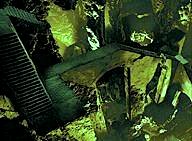
“Here, at an angle, as near as he could judge, of a hundred feet underground, he came upon a square landing-place, with a niche in the wall; and then he saw a further long stair-case, descending at right angles to the first stair-case, and still going down into deep, cold, darkness. The man cast a glance upwards, as if questioning the small segment of light from the upper world which shot down whether he should continue his search, or desist and return. All was stillest of the still about him but he saw no reason particularly to fear. So, imagining that he would in some way soon penetrate the mystery, and feeling in the darkness by his hands upon the wall, and by his toes first on each step, he resolutely descended, and he deliberately counted two hundred and twenty steps.
"He felt no difficulty in his breathing, except a certain sort of aromatic smell of distant incense, that he thought Egyptian, coming up now and then from below, as if from another though a SUBTERRANEAN WORLD. " Possibly," thought he-for he had heard of them-" the world of the mining gnomes; and I am breaking in upon their secrets, which is forbidden for man." The rustic, though courageous, was superstitious.”
“But, notwithstanding some fits of fear, the countryman went on, and at a much lower angle he met a wall in his face; but, making a turn to the right, with a singular credit to his nerves, the explorer went down again. And now he saw at a vast distance below, at the foot of a deeper staircase of stone, a steady though a pale light. This was shining up as if from a star, or coming from the centre of the earth. Cheered by this light, though absolutely astounded-nay, frightened-at thus discovering light, whether natural or artificial, in the DEEP BOWELS OF THE EARTH, the man again descended, meeting a thin, humid trail of light, as it looked, mounting up the centre line of the shining though mouldering old stairs, which apparently had not been pressed by a human foot for very many ages. He thought now, although it was probable only the wind in some hidden recess, or creeping down some gallery, that he heard a murmur overhead, as if of the uncertain rumble of horses and of heavy wagons, or lumbering wains. Next moment, all subsided into total stillness; but the distant light seemed to flicker, as if in answer to the strange sound. Half a dozen times he paused and turned as if he would remount-almost flee for his life upwards, as he thought; for this might be the secret haunt of robbers, or the dreadful abode of evil spirits. What if, in a few moments, he should come upon some scene to affright, or alight in the midst of desperate ruffians, or be caught by murderers. He listened eagerly. He now almost bitterly repented his descent. Still the light streamed at a distance, but still there was no sound to interpret the meaning of the light, or to display the character of this mysterious place, in which the countryman himself was entangled hopelessly.”

"The discoverer by this time stood still in fear. But at last, summoning courage, and recommending himself devoutly to God, he determined to complete his discovery. Above, he had been working in no strange place: the field he knew well, the woods were very familiar to him, and his own hamlet and his family were only a few miles distant. He now hastily, and more in fear than through courage, noisily with his feet descended the remainder of the stairs; and the light grew brighter as he approached, until at last, at another turn, he came upon a square chamber [underground vault] built up of large hewn stones.
"He stopped, silent and awestruck, here was a flagged pavement and a somewhat lofty roof, gathering up into a centre; in the groins of which was A ROSE, CARVED EXQUISITELY IN SOME DARK STONE, OR IN MARBLE.”
[Note: I will pause the story at this point to address the significance of the rose. Usually accompanied with a cross, the rose symbol is widely used within Rosicrucian circles. Andy Lloyd eloquently summarizes the importance of this symbolism from his web-page: ‘The Rosy Cross.’ See below:
“The symbols of the Rose and the Cross are themselves deeply suggestive of Nibiru which was often depicted in the form of a cross by the ancients, as Zecharia Sitchin describes:
“The pictographic sign for the Twelfth Planet, the “Planet of the Crossing”, was a cross. This cuneiform sign, which also meant “Anu” and “divine”, evolved in the Semitic languages to the letter tav, which meant “the sign”.
“This vital observation is often lost during arguments about the nature and timing of this mythical planet and its orbit.
"The earliest symbol of Nibiru was a cross, and this seems inextricably linked to its later Messianic symbolism during the Graeco-Roman era. Nibiru's red countenance perfectly fits with the 'Rosy Cross' symbol used by Freemasons and Rosicrucians, and is connected with esoteric concepts such as the 'Blazing Star', the 'Dark Satellite'…and the 'Eighth Sphere' of the Theosophists.”]
The Staffordshire story continues:
“But what was this poor man's fright when, making another sudden turn, from between the jambs, and from under the large archivolt of a Gothic stone portal, light streamed out over him with inexpressible brilliancy, shining over every thing, and lighting up the place with brilliant radiance, like an intense golden sunset. He started back. Then his limbs shook and bent under him as he gazed with terror at the figure of a man, whose face was hidden, as he sat in a studious attitude in a stone chair, READING IN A GREAT BOOK, with his elbow resting on a table like a rectangular altar, in the light of a large, ancient iron lamp, suspended by a thick chain to the middle of the roof.”
“A cry of alarm, which he could not suppress, escaped from the scared discoverer, who involuntarily advanced one pace, beside himself with terror. He was now within the illuminated chamber. As his feet fell on the stone, the figure started [to] bolt upright from his seated position as if in awful astonishment. He erected his hooded head, and showed himself as if in anger about to question the intruder. Doubtful if what he saw were a reality, or whether he was not in some terrific dream, the countryman advanced, without being aware of it, another audacious step. The hooded man now thrust out a long arm, as if in warning, and in a moment the discoverer perceived that his hand was armed with an iron baton and that he pointed it as if tremendously to forbid further approach. Now, however, the poor man, not being in a condition either to reason or to restrain himself, with a cry, and in a passion of fear, took a third fatal step ; and as his foot descended on the groaning stone, which seemed to give way for a moment under him, the dreadful man, or image, raised his arm high like a machine, and with his truncheon struck a prodigious blow upon the lamp, shattering it into a thousand pieces, and leaving the place in utter darkness.”
“This was the end of this terrifying adventure. There was total silence now, far and near. Only a long, low roll of thunder, or a noise similar to thunder, seemed to begin from a distance, and then to move with snatches, as if making turns; and it then rumbled sullenly to sleep as if through UNKNOWN, INACCESSIBLE PASSAGES. What these were-if any passages—nobody ever found out. It was only suspected that THIS HIDDEN PLACE REFERRED IN SOME WAY TO THE ROSICRUCIANS, AND THAT THE MYSTERIOUS PEOPLE OF THAT FAMOUS ORDER HAD THERE CONCEALED SOME OF THEIR SCIENTIFIC SECRETS. The place in Staffordshire became afterwards famed as the sepulchre of one of the brotherhood, whom, for want of a more distinct recognition or name, the people chose to call " ROSICRUCIUS," in general reference to his order; and from the circumstances of the lamp, and its sudden extinguishment by the figure that started up, it was supposed that some ROSICRUCIAN had determined to inform posterity that he had penetrated to the secret of the making of the EVER-BURNING LAMPS OF THE ANCIENTS, though, at the moment that he displayed his knowledge, he took effectual means that no one should reap any advantage from it.” [End] Pages 890-891.

Who was the mysterious hooded Rosicrucian described above? His identity was never revealed. Prominent Rosicrucians have been identified in the past, however, noted people such as: Dante Alighieri who wrote the ‘Divine Comedy’ including ‘Dante’s Hell,’ Robert Fludd who helped translate the Bible into English for King James I and Sir Francis Bacon who wrote literature on a ‘New Atlantis’ that inspired the colonization of America.
From my investigation though, two men within the brotherhood stand out above all others that quite possibly could have brought fourth ancient knowledge of a mystic second sun. Two very mysterious characters named Christian Rosenkreutz and Count Saint-Germain. It is generally believed Christian Rosenkreuze was nothing more than a fictitious character said to be the founder of the Rosicrucian Order, although Theosophists say he was very real indeed.
Provided below is the biographical romance of Christian Rosenkreutz. His true life (?) account eventually became known as ‘The Chemical Wedding.’
CHRISTIAN ROSENKREUTZ—THE ‘FOUNDER’
Exhibit H) Leslie A.
Shepard (
![]() Encyclopedia Of Occultism And Parapsychology: Vol 2 ©1978)
Encyclopedia Of Occultism And Parapsychology: Vol 2 ©1978)
“…Practically nothing was known concerning the Rosicrucian brotherhood before the publication of Mr. [A. E.] Waite’s work The real history of the Rosicrucians in 1887…the result of arduous personal research, has gathered…facts…drawn from manuscripts, in some cases discovered by himself, and from skilful analogy. As it is the only authority on the subject worth speaking about…”
“…We find then that the name “Rosicrucian” was unknown previously to the year 1598. The history of the movement originates in Germany, where in the town of Cassel in the year 1614 the professors of magic and mysticism, theosophists and alchemists, were surprised by the publication of a pamphlet bearing the title The Fama of the Fraternity of the Meritorious Order of the Rosy Cross Addressed to the learned in General and the Governors of Europe. It purported to be a message from certain anonymous adepts who were deeply concerned for the condition of mankind, and who greatly desired its moral renewal and perfection. it proposed that all men of learning throughout the world should join forces for the establishment of a synthesis of science, through which would be discovered the perfect method of all the arts…”
“…The fraternity kindly supplied an account of its history. The head and front of the movement was one C.R.C. [Christian Rosenkreutz] of Teutonic race, a magical hierophant of the highest rank, who in the fifth year of his age had been placed in a convent, where he learned the humanities. At the age of fifteen, he accompanied one, Brother P.A.L. on his travels to the Holy Land; but the brother died at Cyprus to the great grief of C.R.C., who, however resolved to undertake the arduous journey himself.”
“Arriving at Damascus, he there obtained knowledge of a secret circle of theosophists who dwelt in an unknown [subterranean?] city of Arabia called Damcar, who were expert in magical arts. Turning aside from his quest of the Holy Sepulchre, the lad made up his mind to trace these Illuminati and sought out certain Arabians who carried him to the city of Damcar. There he arrived at the age of sixteen years, and was graciously welcomed BY THE MAGI, who intimated to him that they had long been expecting him, and relating to him several passages in his past life. They proceeded to initiate him into the mysteries of occult science, and he speedily became acquainted with Arabic…After three years of mystic instruction, he departed from the mysterious city for Egypt, whence he sailed to Fez as THE [MAGI]WISE MEN of Damcar had instructed him to do…”
“…He proceeded to Spain…Unhappily, the scholarhood (sic) of Spain [denounced C.R.C.’s magical knowledge and] turned its back upon him with loud laughter…With noble indignation he shook the dust of Spain from his feet, and turned his face to other countries only, alas, to find the same treatment within their boundaries. At last he sought his native land of Germany where he posed over the great truths he had learned in solitude and seclusion and reduced his universal philosophy to writing.”
“Five years of a hermits life, however, only served to strengthen him in his opinions, and he could not but feel that one who had achieved the transmutation of metals and had manufactured the elixir of life was designed for a nobler purpose than rumination in solitude.”
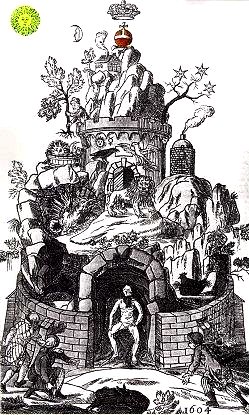
“Slowly and carefully he began to collect around him assistants who became the nucleus of the Rosicrucian fraternity. When he had gathered four of these persons into the brotherhood they invented amongst them a magical language, a cipher writing of equal magical potency, and a large dictionary replete with occult wisdom. They erected a House of the Holy Ghost, healed the sick, and initiated further members, and then betook themselves as missionaries to the various countries of Europe to disseminate their wisdom.”
“In course of time their founder, C.R.C., breathed his last, and for a hundred and twenty years the secret of his burial place was concealed. The original members also died one by one, and it was not until the third generation of adepts had arisen that the tomb of their illustrious founder was unearthed during the re-building of one of their secret [underground] dwellings. The vault in which this tomb was found was illuminated by the SUN OF THE MAGI, and inscribed with magical characters. The body of the illustrious founder was discovered in perfect preservation, and a number of marvels were discovered buried beside him...” Pages 787-788.
In connection with C.R.C’s life story I have highlighted this Rosicrucian diagram (above right) emphasising the Sceptre above his tomb. My argument contends that this celestial red sphere represents the ‘Sun of the Magi’—our second sun-like planet.
Exhibit H) continues:
“…In 1618 Henrichus Neuhuseus published a Latin pamphlet, which stated that the Rosicrucian adepts had migrated to India, and present-day Theosophists will have it that they exist now in the table-lands of Tibet...”
“…A pseudo-Rosicrucian Society existed in England before the year 1836, and this was remodelled about the middle of the last century under the title “ The Rosicrucian Society of England.” To join this it is necessary to be a Mason. The officers of the society consist of THREE MAGI, a master-general for the first and second orders, a deputy master-general, a treasurer, a secretary and seven ancients…”
“…The ‘Rosicrucian Society of England’…was organized in 1865 under the name Societas Rosicruciana in Anglia; a Metropolitan College was founded in London in 1866…Other colleges were later formed in the provinces. Kenneth Mackenzie, author of The Royal Masonic Cyclopaedia (1877) became Honorary MAGUS and gave many lectures to the Society…” Page 789.
As mentioned earlier, it is a known fact that Rosicrucian societies still exist today so one can deduce, based on the above quotes, modern-day Magi continue to operate from within the brotherhood. The Bible tells us that THREE MAGI were synonymous for portending Christ’s birth due to the Star of Bethlehem’s manifestation. I get the impression the Magi knew exactly where to look for it in the sky when the right time arrived. So if the Magi are interwoven into the Rosicrucian fold, one can suggest the ‘Christ Star’ would be interwoven in their symbolic imagery as well. Sure enough this is indeed the case.
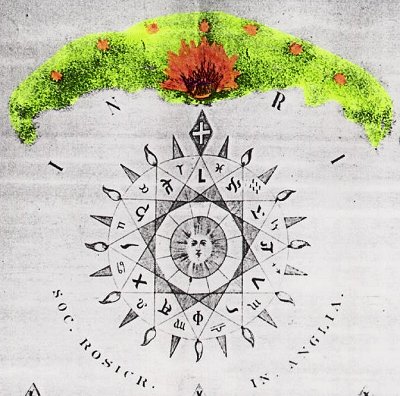
The highlighted picture above is a blow-up of “a certificate of membership in ‘The Societas Rosicruciana’ in Anglia founded in 1886 by a group of Freemasons.” The Rosicrucian Society of England’s certificate clearly shows a crown with seven stars but notice how the crown is represented as a sun directly above our own celestial sun. Is this another representation of the ‘Sun of the Magi’? I say yes!
SUN OF THE MAGI—THE ‘CHRIST STAR’
Exhibit I) Jim Marrs (Rule by Secrecy ©2000)
“[Master Mason]…Pike in his book Morals and Dogma intended only for the inner core of Masonry, made it clear that worship of the sun was an adulteration of an earlier belief. “Thousands of years ago, men worshipped the sun…Originally they looked beyond the orb (our solar system’s sun) to the invisible God…The worship of the Sun (the invisible God) became the basis of all the religions of antiquity…”
“…This secret becomes clearer when closer study reveals that this Great Architect of the Universe is a supreme creative being…Masonic authors draw a DISTINCTION BETWEEN the celestial “sun” and the “Sun” God which they say, is the bringer of light…interestingly enough, the appellation “Morning Star” and “Bringer of Light” were at times applied to Jesus.” Page 263.
This is a remarkable statement because it suggests that the Masons [as well as the Rosicrucians] inherently knew of TWO SUNS! The Celestial Sun and the Sun God dubbed “The Grand Architect of the Universe.” Furthermore, if the Masonic Sun God was associated with the term “Bringer of Light” this infers a direct correlation to the “Christ Star” or the “Sun of the Magi.”

As mentioned in Part One, my research reveals that the two fraternities have acquired ancient knowledge of this second sun-like planet gleaned from subterranean libraries passed down from Elders to Adepts originally coming from, not only Egypt, but from some older civilization such as Mu.
A great example of this two-sun symbology comes from a 19th century Masonic Irish silver dish obtained from the book Freemasonry – A Journey through ritual and Symbol by W. Kirk MacNulty ©1991. (Exhibit J) (above):
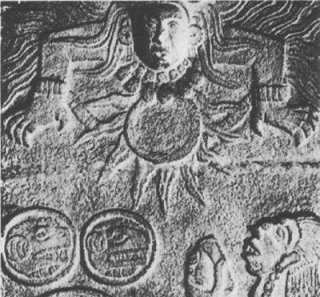
Compare that image to the image above depicting the ‘True Sun’ of the Incas. The similarities are striking to say the least. (Also see Andy Lloyd's webpage ‘The True Sun of the Incas.’)
Another proponent of Lemuria and the knowledge of an invisible Sun-God (The Sun of the Magi) was Max Heindel.
Exhibit K)
James R. Lewis ( ![]() The Encyclopedia of Cults, Sects, and New Religions
©1998)
The Encyclopedia of Cults, Sects, and New Religions
©1998)
“Carl Louis Van Grasshof, a German immigrant, founded the Rosicrucian Fellowship in 1909. Van Grasshof, better known as Max Heindel, settled in Los Angeles in 1903 and began to participate in Katherine Tingley’s Theosophical Society. Heindel was president of the lodge in 1904 and 1905, and gained popularity as a lecturer during that time. In 1907, Heindel made a trip to Germany. During that trip he met an entity [?] identified as an Elder Brother of the Rosicrucian Order. The Elder Brother promised to be of assistance to Heindel. Heindel then traveled to the Temple of the Rosy Cross, near the Bohemian border. There, Heindel received much of the information he later published in his book, The Rosicrucian Cosmo-Conception.”
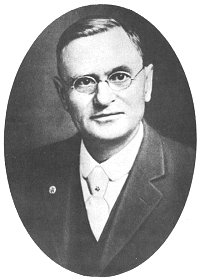
“After his return to America, he opened the first center for the new Rosicrucian Fellowship in Columbus, Ohio. By 1910 there were additional centers in the states of Washington, Oregon, and California. Heindel’s teachings were essentially theosophical. [Derived from the lectures of Rudolf Steiner (1861-1925)—GJ] He discussed the origin, development, and future constitution of the human race and the planet on which it evolves, as well as the spiritual hierarchies in whom this evolution is embedded.
"Heindel incorporated more Christian symbolism and drew more heavily on the history of Rosicrucianism than did most theosophical thinkers. [Another prominent official of the Fellowship was Author Manly P. Hall—GJ]
"The Rosicrucian Cosmo-Conception" is a rare and fascinating book delving deep into mystic Christianity. Although I cannot begin to understand the complex esoteric knowledge within this 610 page volume there are however some points I would like to address regarding the brotherhood’s direct first-hand knowledge of the Nibiru/Dark Star system:
Exhibit K) Max Heindel (The Rosicrucian Cosmo-Conception ©1909)
On page 515 Heindel discusses “ancient truths” associated with Christian Rosenkreutz and the ‘Order of the Rosicrucians.’ Heindel says that our Sun is the physical light bringer that travels from east to west but he also says we have an INVISIBLE SUN [THE DARK STAR] that also travels from east to west.

Then on page 502 the Max Heindel states that “Christ Himself symbolizes the Divine Initiate of the Vulcan Period.” And on page 391 Max Heindel discusses “THE STAR” and how “THE BLAZING STAR is ever there to guide HIM.”

From Pages 410 & 413 notice the symbology of the invisible Sun-God (shown below) and how it portrays the classic Egyptian winged-disc. So as you can observe, Heindel’s book also has deep symbolic clues as to the existence of a Dark Star/Nibiru binary system.
Nibiru and the Lemurian Connection - Part Three
Written by Greg Jenner, author of
![]() Planet X and the Kolbrin Bible Connection
Planet X and the Kolbrin Bible Connection